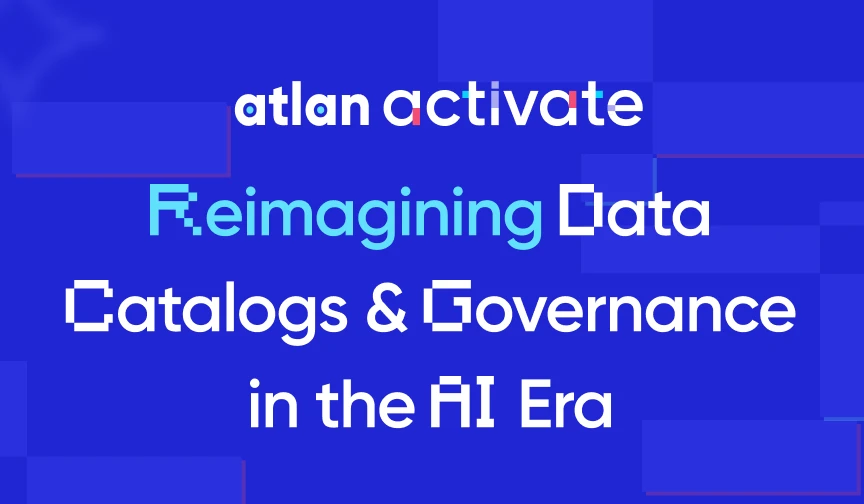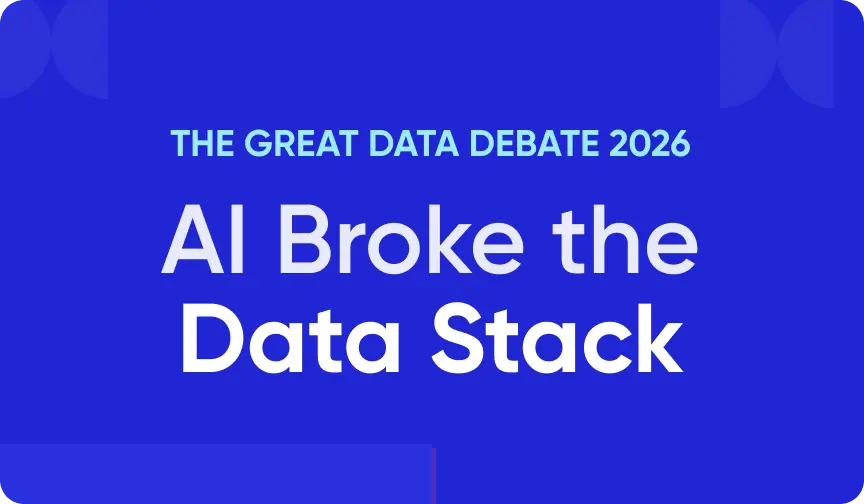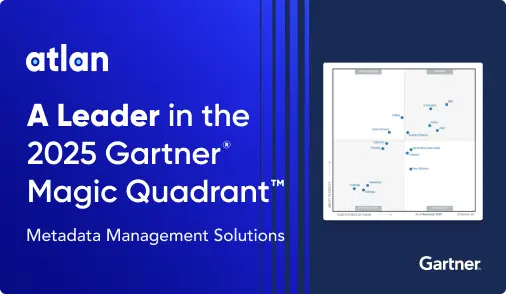Enterprise Metadata Management Solutions: Emerging Trends & Must-Have Product Capabilities in 2025

Last Updated on: July 08th, 2025 | 12 min read
Unlock Your Data's Potential With Atlan

Quick Answer: What are enterprise metadata management solutions?
Permalink to “Quick Answer: What are enterprise metadata management solutions?”Metadata is the foundation for moving “from just a tech stack to a trust stack”. Enterprise metadata management (EMM) solutions help you capture, organize, and operationalize metadata across data systems.
With EMM solutions, you can build a unified layer of context—covering technical, business, operational, and social metadata—to improve data discovery, governance, lineage, and collaboration at scale.
Up next, we’ll explore how enterprise metadata management solutions work, key capabilities to look for, and how they support strategic initiatives like data governance, compliance, and AI readiness.
Table of Contents
Permalink to “Table of Contents”- Enterprise metadata management solutions explained
- What are some of the emerging trends and insights on enterprise metadata management solutions in 2025?
- What product capabilities should you look for in enterprise metadata management solutions in 2025?
- Final thoughts on enterprise metadata management solutions
- Enterprise metadata management solutions: Frequently asked questions (FAQs)
Enterprise metadata management solutions explained
Permalink to “Enterprise metadata management solutions explained”Summarize and analyze this article with 👉 🔮 Google AI Mode or 💬 ChatGPT or 🔍 Perplexity or 🤖 Claude or 🐦 Grok (X) .
Gartner defines enterprise metadata management (EMM) as the business discipline for managing the metadata about the information assets of the organization. That’s why enterprise metadata management solutions are key enablers for driving effective data-driven decisions, analytics, compliance, and data monetization.
Without EMM, metadata sits in silos, making it hard to understand where data comes from, who owns it, or whether it can be trusted.
EMM solutions solve this by creating a unified metadata layer that aggregates and enriches metadata across systems, including:
- Technical metadata: Schema, tables, column types, lineage, system logs
- Business metadata: Data definitions, classifications, glossary terms, KPIs
- Operational metadata: Usage stats, freshness indicators, pipeline status
- Social metadata: Who uses the data, annotations, popularity metrics
By bringing this context together, EMM tools enable better decision-making, enforce data governance policies, streamline compliance, and reduce duplication of effort across data teams.
What are some of the emerging trends and insights on enterprise metadata management solutions in 2025?
Permalink to “What are some of the emerging trends and insights on enterprise metadata management solutions in 2025?”In recent years, metadata management is shifting from tools that provide unidirectional (passive) metadata toward bidirectional (active) metadata access.
Historically, metadata tools focused on passive collection—pulling metadata into centralized repositories for documentation. But these repositories often became stale and disconnected from the real-time needs of users and systems.
Modern enterprises now require active metadata to break down silos and bring metadata to life.
Gartner defines active metadata management as “a set of capabilities that enables continuous access and processing of metadata that support ongoing analysis over a different spectrum of maturity, use cases and vendor solutions.”
Active metadata management goes beyond collection. EMM solutions with active metadata management can constantly process metadata in real time to uncover insights, recommend actions, generate alerts, and trigger workflows across tools.
“For example, by parsing through the SQL code from query logs, an active metadata platform can automatically create column-level lineage, assign a popularity score to every data asset, and even deduce the potential owners and experts for each asset.” - Prukalpa Sankar, co-founder at Atlan, on how active metadata management drives action
This shift reflects how organizations are moving from static metadata management tools to interoperable metadata control planes that sit at the heart of their enterprise data stack.
Today, enterprise metadata management solutions must go beyond cataloging. They need to integrate with your existing tools, push metadata back into them, and trigger actions based on policies or user behavior.
What does this mean for modern enterprise metadata management (EMM) solutions?
Permalink to “What does this mean for modern enterprise metadata management (EMM) solutions?”Today’s EMM platforms must go far beyond cataloging. To truly support enterprise needs, they must:
- Integrate deeply with your existing tools (and be interoperable)
- Push enriched metadata back into those tools
- Trigger intelligent actions based on user behavior, policies, and system events
They must operationalize metadata to orchestrate trust, automation, and action across all systems.
What are some common pitfalls to avoid when evaluating enterprise metadata management solutions?
Permalink to “What are some common pitfalls to avoid when evaluating enterprise metadata management solutions?”Choosing an enterprise metadata management (EMM) solution is all about ensuring long-term usability, integration, and business impact. Here are common missteps to avoid:
- Treating EMM as a documentation-only tool: Many teams evaluate EMM platforms as static catalogs, focusing on metadata collection and documentation. But documentation alone doesn’t solve real-world data problems like access control, ownership ambiguity, or report inaccuracies. Modern EMM should be active, driving automation, visibility, and collaboration across tools and teams.
- Ignoring integration and interoperability: If your metadata platform can’t connect bi-directionally with your data stack—warehouses, BI tools, pipelines, notebooks—it will quickly become stale and underutilized. The ideal solution should embed seamlessly into your daily workflows.
- Overcomplicating setup and adoption: Metadata tools that require heavy customization or consulting support to deploy often fail to scale. Look for platforms that are cloud-native, easy to implement, support open APIs and offer out-of-the-box automation and playbooks to drive adoption.
- Underestimating the importance of business use case support: A strong EMM solution should bridge the gap between technical and business teams. If the platform lacks support for glossaries, domain ownership, or KPI alignment, non-technical users will disengage and governance efforts will suffer. Choose solutions that make metadata easily searchable, explainable, and accessible to all data users, not just engineers.
- Evaluating for today, not for scale: Your metadata needs will grow with your data ecosystem. Choose a solution that scales with volume, variety, and complexity—not one that locks you into rigid workflows or limited integrations. Also, look for solutions that embed automation (e.g., lineage propagation, PII detection, or access policy enforcement) into the fabric of your data operations.
So what does a modern enterprise metadata management (EMM)solution look like in practice? Let’s explore the key product capabilities that define solutions built for 2025 and beyond.
What product capabilities should you look for in enterprise metadata management solutions in 2025?
Permalink to “What product capabilities should you look for in enterprise metadata management solutions in 2025?”When evaluating enterprise metadata management (EMM) solutions today, it’s important to focus on capabilities that support both scale and action. Here’s what to look for:
- Active metadata management: Support for continuous, bidirectional metadata exchange with your data tools—not just collection and storage. This enables real-time updates, triggers, and context-aware actions like auto-tagging or lineage propagation.
- Native integrations with modern data stacks: Your EMM solution should interoperate with data warehouses (Snowflake, BigQuery), pipeline tools (dbt, Airflow), BI platforms (Looker, Tableau), and governance layers (IAM, SSO, SCIM).
- Active, column-level data lineage: Look for solutions that auto-generate lineage (column- and table-level) from SQL logs or transformation logic and visualize data flows across pipelines, reports, and notebooks.
- Embedded data governance controls: Best-in-class EMM platforms let you assign data owners, enforce policies as code, track access, and generate audit logs. This turns governance into a living, embedded process
- Business-friendly metadata experiences: Glossary management, KPI definitions, context panels, and collaboration threads help business users access and understand metadata. This ensures metadata isn’t limited to technical teams.
- Built-in data quality monitoring: EMM solutions should help you measure and monitor data quality through profiling, freshness indicators, rule-based validation, and issue alerts. Metadata should surface where data is stale, incomplete, or inconsistent, before it reaches downstream users.
- Metadata automation and observability: From auto-profiling new assets to triggering alerts for stale or broken data, observability capabilities ensure the reliability and continuity of your metadata layer.
- AI readiness and trust: As AI usage grows, metadata must support explainability, traceability, and quality control. Choose solutions that surface model inputs, flag sensitive data types, and track how data changes impact downstream ML models.
- Flexible architecture and extensibility: Look for open APIs, metadata SDKs, webhook support, and compatibility with cloud-native environments. This ensures your metadata strategy remains adaptable as your stack evolves.
These capabilities ensure your metadata platform becomes an active, trusted control plane for your enterprise data stack.
How Atlan supports modern enterprise metadata management
Permalink to “How Atlan supports modern enterprise metadata management”Atlan is a modern metadata control plane purpose-built for active, collaborative, and scalable enterprise metadata management.
It brings together technical, business, operational, and social metadata in one unified platform and activates that metadata to power real-time governance, discovery, and automation.
With Atlan, business users can search data with Google-like simplicity, view asset popularity, and see usage context and KPIs directly in their tools.
Here’s how Atlan addresses key enterprise metadata needs:
- An active metadata foundation with support for bidirectional metadata flow
- Best-in-class column-level lineage
- Policy automation and governance as code
- Built-in data quality context using metadata, such as freshness, completeness, popularity, and past issues
- Collaborative, business-friendly experience
- Support for AI readiness and explainability
- Cloud-native, open architecture, and endless extensibility
Why Group 1001 chose Atlan for active metadata management of their enterprise data
Permalink to “Why Group 1001 chose Atlan for active metadata management of their enterprise data”Group 1001 is an insurance holding company with numerous brands, including Delaware Life, Gainbridge, Clear Spring Life and Annuities, and several others.
Here’s a snapshot of their data stack:
- Data sources: Data resides in databases, file logic storage, SaaS applications like Zendesk, Google Analytics, Google Ads, and Salesforce.
- APIs: Internal APIs, events and logs
- Core data platform and cloud environments: Snowflake, GCP
- ETL/ELT: Coalesce
- Data orchestration: Dagster
- Quality monitoring: Soda
- BI and analytics: PowerBI, Sigma
One of the biggest challenges for Group 1001 was answering questions from a business user perspective–questions like:
- How do I find X, Y, Z data?
- Where do I find this report? Well, where’s it coming from? How do I get the underlying detail of that information?
- (When something is missing or broken) Okay, what happened? How do I troubleshoot that?
Group 1001’s data team spent over 80% of their team in a reactive mode, looking for the right data needed to address these questions and figuring out how people get access to data.
“I’ve seen data teams can spend upwards of 80% of their time in reactive mode. And if you average it out, it’s usually about a good 40% or 50% of their time spent answering questions. And that is a fundamental sink across all developer productivity in the organization.” - Gu Xie, Head of Data Engineering at Group 1001
The company chose Atlan as their active metadata management platform to organize this chaos and improve data collaboration between engineering, analysts and business teams.
Atlan’s metadata control plane helped activate and operationalize core analytics stack (Snowflake, Fivetran, Coalesce, Dagster, etc.) and will support other cases, such as:
- A holistic view of Group 1001’s enterprise data assets
- Documenting the entire data ecosystem
- Self-service analytics
- Cross-enterprise data governance
- Tracking PII and applying governance and policies related to it
Final thoughts on enterprise metadata management solutions
Permalink to “Final thoughts on enterprise metadata management solutions”As data estates grow more complex and decentralized, traditional metadata management is no longer enough. Organizations need solutions that activate metadata across tools, teams, and workflows in real time.
Modern enterprise metadata management solutions serve as the connective tissue across your data stack. They enable transparency, improve governance, and reduce risk while empowering teams to move faster and make better decisions.
A metadata control plane like Atlan is one such solution that integrates natively with your ecosystem, supports active metadata flows, and embeds collaboration at its core. By making metadata actionable, discoverable, and collaborative, Atlan helps you build a data culture that scales with your business.
Enterprise metadata management solutions: Frequently asked questions (FAQs)
Permalink to “Enterprise metadata management solutions: Frequently asked questions (FAQs)”1. What are enterprise metadata management (EMM) solutions?
Permalink to “1. What are enterprise metadata management (EMM) solutions?”Enterprise metadata management (EMM) solutions are platforms that help organizations manage metadata across systems, teams, and workflows. They unify technical, business, operational, and social metadata into a centralized or federated layer, enabling visibility, governance, and collaboration around data assets.
2. How is EMM different from a data catalog?
Permalink to “2. How is EMM different from a data catalog?”A data catalog is a component of EMM. While catalogs focus on discovering and organizing metadata, EMM solutions provide broader capabilities—such as active metadata integration, policy enforcement, collaboration features, and integration with governance and quality workflows.
3. Why is metadata important for enterprises?
Permalink to “3. Why is metadata important for enterprises?”Metadata provides context. It helps users understand where data came from, how it has changed, who owns it, and whether it can be trusted. This context is critical for governance, compliance, AI/ML readiness, and decision-making at scale.
4. What is active metadata management?
Permalink to “4. What is active metadata management?”Active metadata management goes beyond static metadata collection. It continuously processes metadata, integrates it across tools, and enables real-time automation—like triggering alerts, enforcing access policies, or auto-documenting data flows.
5. What challenges do organizations face without enterprise metadata management?
Permalink to “5. What challenges do organizations face without enterprise metadata management?”Without EMM, organizations struggle with fragmented metadata, inconsistent definitions, duplicate efforts, poor governance, and high compliance risk. Teams waste time searching for data or verifying its trustworthiness instead of using it effectively.
6. How does EMM support data quality?
Permalink to “6. How does EMM support data quality?”EMM solutions can surface metadata related to data freshness, lineage, anomalies, and usage. By integrating with data quality tools or embedding quality checks natively, EMM improves visibility into data reliability and helps prioritize remediation efforts.
7. What should I look for in enterprise metadata management solutions in 2025?
Permalink to “7. What should I look for in enterprise metadata management solutions in 2025?”Key capabilities include:
- Active metadata integration
- Bidirectional metadata sync
- Automated lineage
- Policy enforcement
- Collaboration features
- Role-based access controls
- Support for data quality and compliance
- Integration with your existing data stack—including data warehouses, BI tools, and governance platforms
8. How does Atlan support enterprise metadata management?
Permalink to “8. How does Atlan support enterprise metadata management?”Atlan acts as a metadata control plane, unifying technical, business, operational, and social metadata. It enables active metadata flows, automated lineage, tag-based policy enforcement, and deep collaboration across tools and teams. It’s designed for modern, decentralized data environments.
Share this article
Atlan is the next-generation platform for data and AI governance. It is a control plane that stitches together a business's disparate data infrastructure, cataloging and enriching data with business context and security.
Enterprise metadata management solutions: Related reads
Permalink to “Enterprise metadata management solutions: Related reads”- Data Quality Explained: Causes, Detection, and Fixes
- Data Quality Framework: 9 Key Components & Best Practices for 2025
- Data Quality Measures: Best Practices to Implement
- Data Quality Dimensions: Do They Matter?
- Resolving Data Quality Issues in the Biggest Markets
- Data Quality Problems? 5 Ways to Fix Them
- Data Quality Metrics: Understand How to Monitor the Health of Your Data Estate
- 9 Components to Build the Best Data Quality Framework
- How To Improve Data Quality In 12 Actionable Steps
- Data Integrity vs Data Quality: Nah, They Aren’t Same!
- Gartner Magic Quadrant for Data Quality: Overview, Capabilities, Criteria
- Data Management 101: Four Things Every Human of Data Should Know
- Data Quality Testing: Examples, Techniques & Best Practices in 2025
- Top Takeaways from Gartner D&A Summit 2025: A 5-Minute Recap
- Gartner Magic Quadrant for Data Quality: 2025 Insights
- Data Readiness for AI: 4 Fundamental Factors to Consider
- Role of Metadata Management in Enterprise AI: Why It Matters
- Atlan Launches Data Quality Studio for Snowflake, Becoming the Unified Trust Engine for AI
- Atlan Launches Data Quality Studio for Databricks, Activating Trust for the AI-Native Era





















